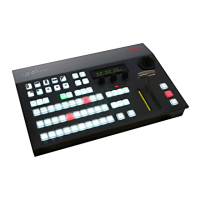
Do you have a question about the Ross CrossOver 12 Solo and is the answer not in the manual?
| Mix/Effect Banks | 1 M/E |
|---|---|
| Frame Synchronizers | 12 |
| Video Inputs | 12 |
| Keyers | 4 |
| Control | RossTalk, GPI |
Details the number and type of serial digital inputs available on the switcher.
Describes the available serial digital outputs, including program, preview, and auxiliary.
Explains the analog reference signal options for synchronization and facility integration.
Covers the storage and recall of stills, logos, and animations with alpha channels.
Details the Multi-Level Effects system, including keyers, patterns, and effects.
Describes the integrated pattern generator for creating various wipes and effects.
Explains the matte and complex wash generator capabilities for color washes and edge effects.
Details the 2D DVE engine for creating picture-in-picture and other graphic effects.
Highlights the advanced chroma keying technology for high-quality keying.
Explains the FlexiClean feature for providing a separate program output for specific productions.
Describes the functionality for storing and recalling memories, stills, and animations via USB.
Details the switcher's ability to store up to 100 complete snapshots of its configuration.
Discusses the user interface elements, including glow colors and on-air indicators.
Explains the Memory AI function that protects program output during memory recalls.
Describes the integrated multi-viewer for monitoring multiple video sources.
Covers the 24 GPI I/Os for interfacing with external equipment and automation.
Details the 8 pre-assigned tally relays for external indicator integration.
Explains the FlexDevice system for controlling external devices via specific drivers.
Lists the available system documentation, including user guides and quick-start posters.
Provides details on the 24-hour hotline and technical support services.
Outlines the product's warranty coverage, including fader handles.
Details the primary configuration of the CrossOver 12 Solo, highlighting its compact and powerful design.
Describes the integration of XPression Designer for graphics creation and transfer.
Explains the hardware package for transitioning video signals with embedded audio.
Details the package for copying Live Edit Decision List information for non-linear editors.
Covers the redundant power supply option for protection against AC power failure.
Describes mounting solutions for the control panel, allowing desk or rack installation.
Details the option for input and output support of analog video formats.
Explains the availability and process for onsite operational training for the switcher.
Describes the option to extend the standard one-year warranty for the switcher.
Details the physical dimensions, width, depth, and height of the CrossOver 12 Solo.
Provides the dimensions required for integrating the control panel into a desk environment.
Lists and describes all the connector types found on the switcher for various interfaces.
Details the input voltage, maximum current, and impedance specifications for power.
Outlines the power consumption details, including wattage and input voltage ranges.
Specifies the ambient temperature range and control panel cooling method.
Details the supported video formats, input/output standards, and equalization.
Describes the number of video inputs, equalization, impedance, and return loss.
Details the number of video outputs, return loss, rise/fall time, and signal levels.
Specifies the jitter characteristics for different video modes and reference types.
Covers system timing parameters, including input alignment and system delay.
Details the video formats supported by different reference input types.
Lists the primary CrossOver 12 Solo Multi-Definition Live Production Switcher model.
Summarizes various optional hardware and software packages available for the switcher.